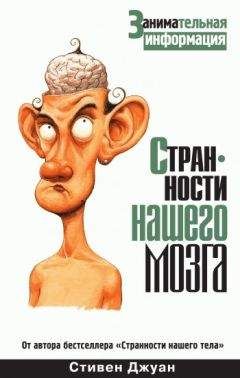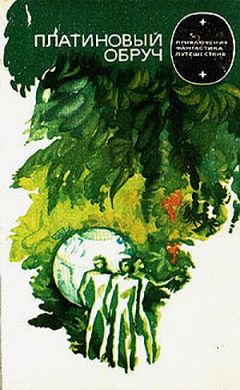Стивен Джуан - История мозга. 1640 фактов
4. Juan S. A pill to tame the gluttonous brain // The Sydney Morning Herald. 16 July 1992. P. 12.
5. Исследование Г. Шварца и др. приводит Дж. Ралофф. How the brain knows when eating must stop // Science News. 30 November 1996. P. 343. Доктор Гэри Шварц и коллеги – психологи из Университета Джона Хопкинса.
6. Исследование Т. Лэндиса и М. Регард приводит У. Карлсен. Brain lesions can spark at cravings for fi ne food // The San Francisco Chronicle. 20 May 1997. P. A1 – A15. Доктор Теодор Лэндис – невролог из Женевы, доктор Марианна Регард – невролог из Цюриха.
7. Исследование У. Родригеса приводит П. Доскох. Ah, sweet memories // Psychology Today. November – December 1996. P. 20. Доктор Уорд Родригес – психолог из Калифорнийского университета в Хэйворде.
8. Исследование С. Киша и др. приводит Б. Уоллес. «Speed» abusers need more and more // The San Francisco Chronicle. 31 May 1996. P. A2. Доктор Стивен Киш и коллеги работают на факультете психиатрии в Торонтском университете.
9. Исследование М. Грациано и др. приводит А. Мотлак. Neurons for lovers // New Scientist. 19 July 1997. P. 16. Доктор Майкл Грациано и коллеги – неврологи из Принстонского университета.
Глава 14. Галлюцинирующий мозг
1. Teunisse R., Cruysberg R., Hoefnagels W., Verbeek A., Zitman F. Visual hallucinations in psychologically normal people: Charles Bonnet’s Syndrome // The Lancet, 1996. Vol. 347.
P. 794 – 797. Доктор Р. Дж. Тонисс и коллеги – психиатры в госпитале Университета Неймегена в Нидерландах.
2. Fenelon G., Marie S., Ferrior J., Guillard A. Musical hallucination: 7 cases. P. : Revue Neurologie, 1993. Vol. 149. Nos. 8 – 9. P. 462 – 467. Доктор Дж. Фенелон и коллеги работают в парижской больнице Тенон.
3. Nagaratnam N., Virk S., Brdarevic O. Musical hallucinations associated with recurrence of a right occipital meningioma // British Journal of Clinical Practice. 1996. Vol. 50. No. 1. P. 56 – 57.
4. Stephane M., Hsu L. Musical Hallucinations: Interplay of degenerative brain disease, psychoses and culture in a Chinese woman // Journal of Nervous Mental Disease. 1996. Vol. 184. No. 1. P. 59 – 61.
5. Hallucinations: Behavior, Experience and Theory / R. Siegel. N. Y.: Wiley, 1975.
6. Walter H., Podreka I., Steiner M., Suess E. A contribution to classifi cation of hallucinations // Psychopathology. 1990. Vol. 23. No. 2. P. 97 – 105. Доктор Г. Уолтер и коллеги – психиатры из Венского университета.
7. Shulman P. Seeing things // Discover. July 1996. P. 30.
8. Juan S. Seeing something that is not there // The Sydney Morning Herald. 17 October 1991. P. 12.
9. Исследование У. Рэнделла и С. Рэнделл приводит У. Корлисс. The solar wind and hallucinations // Science Frontiers. September – October 1994. P. 4. Доктора́ У. Рэнделл и С. Рэнделл – психологи в университете Айовы.
10. Scientifi c American. A fi sh smarter than a man // Scientifi c American. October 1996. P. 28.
Глава 15. Счастливый мозг
1. Kramer P. Listening to Prozac. N. Y.: Viking Press, 1993.
2. Fisher S., Greenberg R. Prescription for happiness? // Psychology Today. September-October 1995. P. 32 – 37.
3. Juan S. Carroll’s dream or Huxley’s nightmare? // The Sydney Morning Herald. 10 November 1993. P. 13.
4. Исследование М. Мизерандино приводит М. Хеттингер. The power of positive thinking // Your Health. 3 September 1996. P. 18. Доктор Марианна Мизерандино – психолог из Орегонского медицинского университета в Портленде.
5. Chalmers D. The puzzle of conscious experience // Scien-tifi c American. December 1995. P. 80 – 86. Доктор Дэвид Чалмерс – профессор философии из Калифорнийского университета в Санта-Крус и автор книги «Познающий разум», опубликованной Oxford University Press в 1996 г.
6. Исследование Х. Дамазио и А. Дамазио приводит Т. Монмэни. Study on brain paths a surprise // The Los Angeles Times. 11 April 1996. P. 1. Доктора́ Ханна и Антонио Дамазио работают в медицинском колледже университета Айовы.
Глава 16. Внушаемый мозг-1: увеличение груди под гипнозом, или Как вытащить кролика из шляпы
1. Poundstone W. Biggest Secrets. William Morrow. 1993. P. 159 – 161, 193 – 199.
2. Juan S. Rabbits are not the only ones kept on the dark // The Sydney Morning Herald. 3 November 1993. P. 13.
3. Williams K. Stimulation of breast growth by hypnosis // Journal of Sex Research. 1974. Vol. 10. No. 4. P. 316 – 326. Доктор Джеймс Уильямс был психологом в Университете Северной Каролины в Чапел-Хилл.
4. Willard R. Breast enlargement through visual imagery and hypnosis // American Journal of Clinical Hypnosis. 1977. Vol. 19. No. 4. P. 195 – 200. Доктор Ричард Уиллард – психиатр из Института изучения поведения и сознания в Форт-Уэйне, Индиана.
5. Juan S. Bigger breasts? Just give it some thought // The Sydney Morning Herald. 20 October 1988. P. 20.
6. Klawans H. Life, Death and In Between Tales of Clinical Neurology. N. Y.: Paragon House, 1992. P. 139.
7. Исследование С. Вайсса приводит Дж. Глаузиуц. Brain, heal thyself // Discover. August 1996. P. 28 – 29. Доктор Сэмюэль Вайсс – невролог в университете Калгари.
Глава 17. Внушаемый мозг-2: память, регрессия и «эффект Свенгали»
1. Whitehouse W., Dinges D., Carota Orne E., Orne M. Hypnotic hyperamnesia: Enhanced memory accessibility of report bias? // Journal of Abnormal Psychology. 1988. Vol. 97. No. 3. P. 289 – 295. Доктор Уэйн Уайтхаус и коллеги – психиатры кафедры экспериментальной психиатрии Пенсильванского университета в Филадельфии.
2. Juan S. Going back in time can be harder than you think // The Sydney Morning Herald. 6 April 1989. P. 13.
3. Nash M. What, if anything, is regressed about hypnotic age regression? A review of the empirical literature // Psychological Bulletin. 1987. Vol. 102. No. 1. P. 42 – 52. Доктор Майкл Нэш работает в отделении психологии в университете Теннесси в Ноксвилле.
4. Young P. Is rapport an essential characteristic of hypnosis? // Journal of Abnormal and Social Psychology. 1927. Vol. 22. P. 130 – 139.
5. Young P. The nature of hypnosis: As indicated by the presence or absence of posthypnotic amnesia and rapport // Journal of Abnormal and Social Psychology. 1928. Vol. 22. P. 372 – 382.
6. Wells W. Ability to resist artifi cially induced dissociation // Journal of Abnormal and Social Psychology. 1940. Vol. 35. P. 261 – 272.
7. Hilgard E. Ability to resist suggestion within the hypnotic state: Responsiveness to confl icting communications // Psychological Reports. 1963. Vol. 12. P. 3 – 13.
8. Baker E., Levitt E. The hypnotic relationship: An investigation of compliance and resistance // International Journal of Clinical and Experimental Hypnosis. 1989. Vol. 37. P. 145 – 153.
9. Lynn S., Rhue J., Weekes J. Hypnotic involuntariness: A social cognitive analysis // Psychological Review, 1990. Vol. 97. No. 2. P. 169 – 184. Доктор Стивен Линн и коллеги работают на факультете психологии университета Огайо.
10. Juan S. A suggestive little theory on hypnosis // The Sydney Morning Herald. 4 October 1990. P. 16.
11. Sacks O. The Island of the Colour Blind. Sidney: Picador, 1996.
12. Glauziusz J. Brain, heal thyself // Discover. August 1996. P. 28 – 29.
Глава 18. Клептомания: жадный мозг, или Когда вы просто обязаны это иметь!
1. McElroy S., Pope H., Hudson J., Keck P. , White K. Kleptomania: A report of 20 cases // American Journal of Psychiatry. 1991. Vol. 148. P. 652 – 657. Доктор Сьюзан Макэлрой и коллеги – психиатры из Гарвардского университета.
2. McElroy S., Keck P. , Phillips K. Kleptomania, compulsive buying, and binge-eating disorder // Journal of Clinical Psychiatry. 1995. Vol. 56. Suppl. 4. P. 14 – 26.
3. Chong S., Low B. Treatment of kleptomania with fluvox-amine // Acta Psychiatrica Scandinavia. 1996. Vol. 93. No. 4. P. 314 – 315. Доктора́ С. А. Чонг и Б. Л. Лоу – психиатры из Института психического здоровья в Сингапуре.
4. Juan S. Kleptomania // The Sydney Morning Herald. 19 September 1991. P. 12.
5. Gossling H., Rosin J. Kleptomania before and after spontaneous subarachnoid hemorrhage – a neuropsychodynamic case report // Fortschritt der Neurologie-Psychiatrie. 1994. Vol. 62. No. 5. P. 164 – 168. Доктора́ Г. У. Госслинг и Дж. Росин – психиатры из Ганноверской клиники психиатрии и психотерапии.
6. Исследование М. Фостера и др. приводит Дж. Ралофф. Radicals linked to aging vis the brain // Science News. 18 May 1996. P. 311. Доктор Майкл Фостер и коллеги работают в медицинском научном центре университета Северного Техаса в Форт-Ворте.
7. Clayman С. The Human Body. N. Y.: Dorling Kindersley, 1995. P. 83.
8. Klawans H. Toscanini’s Fumble and Other Tales of Clinical Neuro logy. N. Y.: Bantam Books, 1988. P. 74. Доктор Гарольд Клэванс – невролог из Медицинского пресвитерианского центра Сент-Люка в Чикаго.
Глава 19. Отравленный мозг: Болванщик и безумие Исаака Ньютона
1. Spargo P. , Pounds C. Newton’s ‘derangement of the intellect’: A new light on an old problem // Notes and Records of the Royal Society of London. 1979. Vol. 34. P. 11 – 32.
2. Klawans H. Newton’s Madness: Further Tales of Clinical Neurology. N. Y.: Harper, Row, 1990. P. 30 – 39.
3. Интервью с М. Инуе от 1 июля 1991 г. приводит С. Джуан. Sir Isaac was ripe for ‘Mad Hatters’ malady // The Sydney Morning Herald. 25 July 1991. P. 12.
4. Emond S. Mercury: Still a hazard after all these years // The Harvard Medical Letter. November 1990. P. 7 – 8.
5. Clarkson T. Mercury: Major issues in environmental health // Environmental Health Perspective. 1993. Vol. 100. P. 31 – 38. Доктор Т. У. Кларксон работает в медицинской школе при университете Рочестера.
6. Kang-Yum E., Oransky S. Chinese patent medicine as a potential source of mercury poisoning // Veterinary and Human Toxicology. 1992. Vol. 34. P. 235 – 238.
7. U. S. Centers for Disease Control and Prevention. Mercury poisoning associated with beauty cream – Texas, New Mexico, and California // MMWR Morbidity, Mortality Weekly Report. 1996. Vol. 45. P. 400 – 403.
8. Saxe S., Snowdon D., Wekstein M., Henry R., Grant F., Don-egan S., Wekstein D. Dental amalgam and cognitive function if older women: Findings from the nun study // Journal of the American Dental Association. 1995. Vol. 126. P. 1495 – 1501. Доктор С. Сакс и коллеги участвуют в программе стоматологического здоровья пожилых людей, организованной в колледже стоматологии и медицинском центре Чандлера, университет Кентукки.
9. Corliss W. Fungal Phantasms // Science Frontiers. November – December 1995. P. 4.
10. Исследование А. Холдкрофт и др. приводит П. Мур. Pregnant women get that shrinking feeling // New Scientist. 11 January 1997. P. 5. Доктор Анита Холдкрофт и коллеги работают в Королевской медицинской школе в Лондоне.
Глава 20. Смертоносный мозг-1: рождение убийцы
1. Hellman D., Blackman N. Enuresis, fi resetting and cruelty to animals: A triad predictive of adult crime // American Journal of Psychiatry. 1966. Vol. 222. No. 6. P. 1431 – 1435. Доктора́ Даниэль Хэллман и Натан Блэкман – психиатры Центра психического здоровья Малколма Блисса в Сент-Луисе.
2. Justice B., Justice R., Kraft I. Early-warning signs of violence: Is a triad enough? // American Journal of Psychiatry. 1974. Vol. 131. No. 4. P. 457 – 459. Доктор Блэр Джастис и коллеги работают в Школе общественного здоровья в Техасском университете в Хьюстоне.
3. Lewis D., Shanok S., Grant M., Ritvo E. Homicidally aggressive young children: Neuropsychiatric and experimental correlates // American Journal of Psychiatry. 1983. Vol. 140. No. 2. P. 148 – 153. Доктор Дороти Льюис и коллеги – психиатры из медицинского центра Нью-Йоркского университета.
4. Kellert S., Felthous A. Childhood cruelty toward animals among criminals and noncriminals // Human Relations. 1985. Vol. 38. No. 12. P. 1113 – 1129. Доктор Стивен Келлерт работает в Йельском университете, доктор Алан Фелтхаус – в Техасском университете в Галвестоне.
5. Kelso J., Stewart M. Factors which predict the persistence of aggressive conduct disorder // Journal of Child Psychology and Psychiatry. 1986. Vol. 27. No. 1. P. 77 – 86. Доктора́ Джейн Келсо и Марк Стюарт работают на факультете психиатрии университета Айовы.


